| Biomechanical Observations in Hammer Throwing - Distinguishing the Static and the Dynamic |
| By: Andreas V. Maheras, Ph.D.
Originally Published in: Techniques Magazine Provided by: USTFCCCA The complex special structure of the hammer throw, and the relatively long time that is used to obtain the final speed of the hammer, make it possible that small changes can be the causes of the differences in the distance thrown. Those differences range between fifteen and twenty meters, that is, between the world elite and mediocre throwers. This narrative will focus on certain biomechanical observations of the event that can be considered central during its execution. BASIC CONSIDERATIONS To throw the hammer as far as possible, the thrower makes two or three preliminary winds in which both feet remain in contact with the ground, followed by three or four rotations in which the thrower turns with the hammer as a system. The distance achieved by the hammer when the aerodynamic resistances are not considered, is determined in a major way by the speed of the hammer at the moment of release and, in a lesser way, by the angle of projection and the height of release. An application of the theoretical model that predicts the range of a projectile would show that the optimum angle of projection would be close to 45 degrees in spite of the fact that the hammer is released above the ground. Following those generic aspects of the hammer throw it is necessary to make the temporal description of the phases that determine it, in order to better understand the factors that influence their effectiveness. By observing a throw, three phases can be distinguished chronologically: a) The winds, when the hammer is rotated around the thrower, usually 2 or 3. b) The turns, when the hammer and the thrower rotate around a common axis, usually 3 or 4 turns. c) The release, which comprises of a short interval of time from the beginning of the last double support until the hammer is released. The objective of the winds is to impart mostly horizontal speed and establish an initial plane of motion to the hammer to better be able to initiate the turns. The objective of the turns is to accelerate the hammer and change its plane of motion, the goal being to obtain a high final velocity and an angle of projection close to 40 degrees. Taking into account the positions adopted by the thrower in each turn, this can be divided into two distinct periods: a) Double support, where both feet remain in contact with the ground. b) Single support, where the thrower rotates keeping only the left foot on the ground (right hand throwers). Historically, special attention has been devoted to those two periods, based on the general belief that the hammer can only be accelerated during the period of double support, and that the thrower cannot actively influence the speed of the hammer during the single support phase. This belief has been questioned by Dapena (1984, 1986, 1989) and Bartlett (1992, 1994) both showing that it is possible to increase the speed during the single support period. Analyzing the trajectory of the hammer with respect to an inertial reference system, the throwing action assumes a quite complex movement, composed of the sum of many different movements (Dapena, 1984, 1986). That is, a) A circular movement of the hammer around the athlete. b) A gradual change in the inclination of the plane of the hammer in order to obtain an angle that approximates the theoretical 45 degrees with respect to the horizontal plane. c) A horizontal translation of the entire system, thrower plus hammer, through the throwing circle. 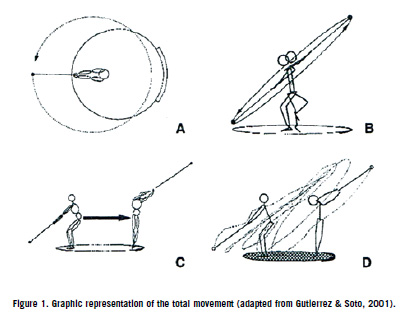 FORCE INTERACTION Considering the circular movement of the hammer throwing system, to achieve a certain amount of angular momentum it is necessary to apply the greatest possible eccentric force. This force produces a circular trajectory, both of the hammer and of the thrower, and an internal force of the system that is translated in terms of the effort that the thrower has to exert on the hammer due to the centripetal force, that is, a force pointing towards the center of the circular path that the ball follows. This force is exerted through the cable. As the thrower-plus-hammer system advances across the circle, one may think that the thrower uses forces resulting from the friction between his/her feet and the ground to resist against being pulled forward, much like what happens in tug-of-war (Woicik, 1980). However, the dynamics of the two activities are quite different and it is clear that this does not happen in the hammer throw; one should think of the thrower and the hammer as if they were a two-star system, a small one and a large one that revolve around a common turning center (Dapena, 1986). In hammer throwing, the reactionary forces that keep the hammer ball on its circular path, also serve to keep the thrower on her own, circular path. This implies that the thrower does not push forward on the ground in order to stay in place. Figure 2 shows what happens in what could be called a tug-of-war scenario (Dapena, 2007). Here, F1 is the forward force made by the wire on the hands; F2 is the weight; F3 is the vertical force made by the ground on the foot; F4 is the horizontal force made by the ground on the foot. F2 is about the same size as F3, so they essentially cancel each other out; F1 is about the same size as F4, so they also cancel out. The sum of all the forces made on the thrower is approximately zero and he/she not moving at all (in a static condition). In other words, the body of the thrower experiences no linear acceleration.  The phenomenon described shows that some of the forces required to maintain the static balance of the tug-of-war athlete are not necessary for the dynamic balance of the rotating hammer thrower. It also shows the need for coaches to make a distinction between static and dynamic balance when dealing with hammer throwing. Figure 5 shows a scheme of the hammer throwing system, where the big star would be the thrower, with a mass (ml), a radius of rotation of its center of gravity (Cg.) with respect to the center of rotation of the system (rl) and a tangential velocity of its Cg., (v1). The small star is the hammer with a mass m2, a radius of rotation (r2) and a tangential velocity (v2). Considering that there are no forces external to the system in circular motion, the angular momentum is expressed as a direct relation to the mass and the product corresponding to the radius of rotation and the velocity vector of the Cg., both of the thrower and of the hammer, respectively as shown below. 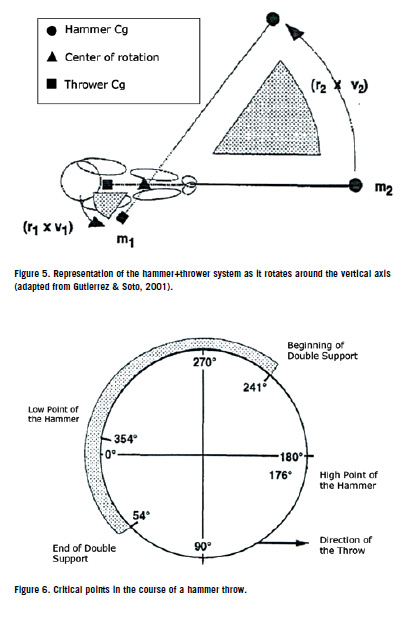 In (1), ml and m2 correspond to the masses of the thrower and hammer, respectively, rl and r2 to the radius of rotation of the thrower and the hammer respectively and vl and v2, to the tangential velocity of the Cg. of the thrower and the hammer respectively. If we consider that the mass of the hammer is constant (7.26 Kg) and that it would be desirable to achieve a large area of sweep of the hammer, expressed via (r2 x v2), then as the mass of the thrower increases, the value of (r2 x v2) will increase proportionally, which would increase, both the hammer radius and its tangential velocity, assuming that the angular momentum is the same, or similarly, exerting the same effort. Following Hay (1980), when considering the circular movement of the hammer from a purely cinematographic point of view and using the expression (2) (2) v=wr where v corresponds to the tangential velocity, w, the angular velocity and r, the radius of rotation of the hammer, the fol-lowing conclusions are drawn: a) When the angular velocity of the hammer (w) is constant and the radius (r) increases, the tangential velocity of the hammer (v) increases. b) When the radius is kept constant and the angular velocity is increased, the tangential velocity increases. c) In any case, the greatest increase in tangential velocity occurs when both the angular velocity and the radius increase. PERIODS OF DOUBLE AND SINGLE SUPPORT It seems normal that traditionally coaches have sought to extend the period of double support after the technical changes proposed by Bondarchuk (1979, 1987). The logic used to make the proposal to increase the period of double support is very simple. When it is intended to increase the angular velocity of the hammer around a vertical axis (horizontal velocity), it is easier to do it when the two feet are in contact with the ground than when in a single support. As a conclusion of this logic, many practitioners proposed that it is necessary to have a period of double support of greater duration in each turn, and that it is necessary to reduce the duration of the single support phase in each turn. In the speed graphs of the hammer obtained by cinemato-graphic techniques (Kuznetsov, 1985, Dapena, 1984, 1989 and Bondartschuk, 1987) fluctuations of the speed are observed very marked in each turn, accelerating only in the period of double support, a fact that apparently reinforces, this theory. Starting a few decades ago, important technical elements were introduced by practitioners and others (e.g., Tschiene, 1980; Samozvetov, 1971) to maximize the period of double support. The thinking behind those movements is based on the simple model: double-support = when the thrower can increase hammer velocity, single-support = a waiting period. DOUBLE SUPPORT REVISITED 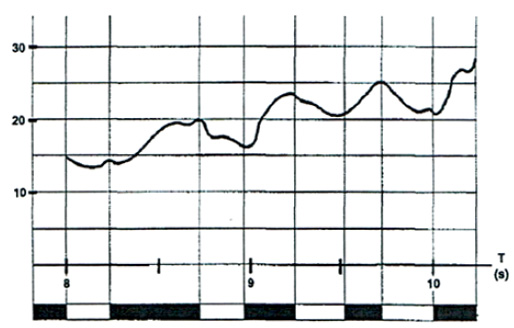 However, just because two quantities coincide in time does not mean that one causes the other. In fact, no direct cause and effect link has been shown between the double-support phase and the increase in hammer velocity (Dapena, 1989). Moreover, film analysis data may not fully support the theory either (Gutierrez, Soto & Rojas, 2002, Panoutsakopoulos, 2006). It is possible then that the association between hammer velocity increase and the double-support is spurious and coincidental and, importantly, that there may be other factors involved. One such a factor may be gravity. As the hammer moves upwards and downwards in its sloped plane of movement, gravity naturally will affect its velocity. Another factor may be the horizontal translation of the thrower-plus-hammer system. translation of the thrower-plus-hammer system across the circle. Such a combined movement will affect the velocity of the hammer (for a detailed explanation see Maheras, 2010, 2011). These two factors, gravity and horizontal translation, can be mathematically accounted for and subsequently removed from consideration when the hammer velocity is calculated (Dapena, 1984). Under these circumstances, in some throwers, the fluctuations observed in the velocity of the hammer disappeared. Yet in others, there was still indication of this fluctuation. Thus, it is possible that other factors may also be affecting hammer velocity in some throwers. Another problem with the "long double-support" hypothesis is that it only considers rotation about the vertical axis. This implies that the motion of the hammer ball is only on a horizontal plane (Woicik, 1980). In reality, however, the motion of the hammer also takes place about the horizontal axis, which implies motion of the ball on a vertical plane (Figure 1b). Therefore, the circular trajectory of the hammer is produced through an inclined axis that allows it to obtain a release angle of c. 45 degrees with respect to a plane parallel to the direction of the throw and the horizontal of the ground. The rotation of the hammer around the horizontal axis means that, in the trajectory described by the head of the hammer, there is a high point and a low point that define the angle of the hammer movement plane with respect to the horizontal of the ground and in which instance the vertical component changes direction. Figure 6 shows the location, on the azimuthal angle of the high and low point, as well as the period of double support and single support, according to Dapena (1986) on high-level throwers. The fact that there is a circular movement around the vertical axis and another through the horizontal axis means that to increase the speed of the hammer, it is necessary to apply an eccentric force around a vertical axis, but it is also necessary to apply force around a horizontal axis. The results of the investigations carried out by Dapena (1986) indicate that, of the total increase in the speed experienced by the hammer during the turns, only a small part is associated with the moment of force around the vertical axis (horizontal velocity), while for the most part, the increase in hammer speed is associated with the application of force around the horizontal axis (vertical velocity). In other words, the majority of velocity increase during the turns is vertical velocity and only a small part of the increase is horizontal velocity (Dapena, 1989). It is true that the horizontal velocity of the hammer can be increased much more effectively during double-support than during single-support. However, this is only the case when the thrower is rotating very slowly. During the winds (when the speed of rotation is slow and the thrower is all the time in double-support), the thrower increases the horizontal velocity of the hammer. But by the time the turns start, the hammer is turning fairly fast, and the body of the thrower is also turning pretty fast. As a result, during the turns, no more horizontal velocity of the hammer can be generated, regardless of whether it is at an instant in which the thrower is in single-support or at an instant in which the athlete is in double-support (Dapena, 1989, 2007). What we see is that the hammer does indeed gain velocity during the turns but it does not gain any horizontal velocity, all the gain is in the vertical (also in Murofushi et al., 2007), and has nothing to do with the thrower being in double-support or in single-support. Finally, Bondartsuck (2009) postulated that: "Contrary to common assumption, the double support phase is not the key to greater acceleration of the hammer and longer throws. World record holder Yuriy Sedych threw farther when total time of the throwing foot contacts was shorter, as do the best today". 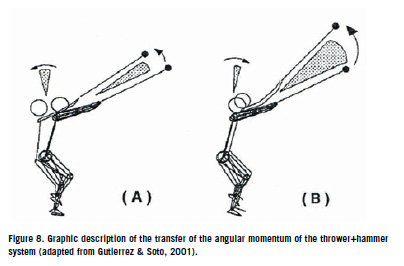 Therefore, to accelerate the hammer, the thrower needs to create two moments of force, one about the vertical axis and another about the horizontal, the latter being the most significant to produce the desired speed change. Figure 7 shows the general speed graph of the hammer, adapted from Kuznetsov (1965) and confirmed by both Bondartschuk (1987) and by Dapena (1989). It shows that the speed increases only during the period of double support, while during the single support period that increase does not exist. This makes us think that it is only possible to accelerate the hammer during the period of double support, and that during the period of single support there is usually a significant reduction in speed and only high-level throwers manage to retain speed. This means that, according to the reasoning given and based on the aforementioned data, exerting force during the single support on the hammer can for certain throwers be, negative, which reflects that for those throwers the period of single support represents only a mere transition, a waiting period, before continuing accelerating the hammer in the ensuing double support. It seems unquestionable that there are fluctuations in the graph of the speed of the hammer in each turn, but as described earlier, Dapena (1989) questions that the only cause of the acceleration and deceleration of the hammer is due to the fact of being in double support or single support, respectively. The influence of gravity and the horizontal translation of the system will affect the uncorrected velocity of the hammer. Again, the results obtained showed a reduction in the magnitude of the velocity fluctuations which in some throwers disappeared almost completely. Dapena (1989) concluded that, in certain throwers, almost all the hammer speed fluctuation is due to the combined effect of gravity and the horizontal movement of the thrower and hammer system on the throwing circle and not to the fact of being in double support. On the contrary, in other throwers he found that there was still a very clear fluctuation in hammer speed, even after subtracting the effects of gravity and horizontal movement. Due, probably, to the moments of force generated through the vertical axis due to the torsion of the trunk relative to the hips, it is possible that the period of double support has a casual influence on the increase in the speed of the hammer, although it can also be due to a good transfer of the angular momentum generated through the horizontal axis, when it is in double support, and a bad transfer when it is in single support, as we will see below. TRANSFER OF ANGULAR MOMENTUM ABOUT THE HORIZONTAL AXIS As described in the investigations carried out by Dapena (1989), most of the increase in the speed experienced by the hammer, during each turn, is associated with the force created around the horizontal axis, which causes an increase in the angular momentum, through that same axis, on the thrower and hammer system. To describe how the thrower accelerates the hammer using the angular momentum of the system, coming from the application of a moment of force, consider that in figure 8a, as also in figure 8b, the value of the angular momentum through a horizontal axis is the same and that forces external to the system do not act. In Figure 8a the angular momentum produced by a force moment counter-clockwise, around the horizontal axis, as well as the sweep area of the hammer, as described by the Cg. of the hammer with respect to the center of rotation of the hammer + thrower system, is a situation where all the segments remain in the same position, and there has been no movement within the system. 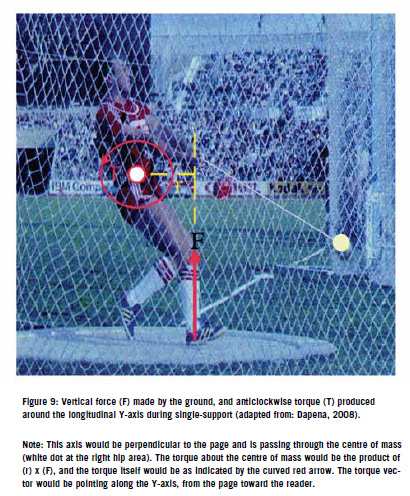 According to the above, it is important that the thrower generate force through the horizontal axis, then transfer the angular momentum to the hammer. The question is to know how the thrower creates those forces, both in double support and in single support. In order to describe how the force in single support is generated, it is necessary to examine Figure 9, where the diagram of the forces that are prevalent when the thrower is in single support is shown. During single-support, the torque is produced automatically because the point of support, which is the left foot, is not directly under the thrower, and the reactionary vertical force generated by the ground on the left foot exerts a torque about a longitudinal axis passing through the center of mass (CM). To better picture this effect, we can picture someone standing with both feet on the ground, if they were to remove the right foot without making any other changes, would fall toward the right. However, this is not the case during hammer throwing because the torque that the thrower receives from the ground is transmitted to the hammer. This way, the thrower does not fall despite the fact that the point of support (the left foot) is not directly beneath his/her CM while at the same time the hammer accelerates. During the phase of double support, the thrower can also receive a moment of force around the horizontal axis. According to Dapena (1989 and 2008), the torque in the vertical direction (about the horizontal axis) is generated during double-support as follows: First, the thrower presses harder on the ground with the left foot than with the right foot and/or second, the thrower generates vertical forces on the ground with both feet, but keeps the CM of the thrower-hammer system closer to the right foot than to the left foot, instead of half-way between them (Figure 9; also for a more detailed explanation see Maheras, 2010, 2011). In Figure 10 on top, the total amount of torque produced equals zero. In the middle of Figure 10, the CM is still halfway between the two legs but the left foot exerts a larger torque and the net effect, the difference between the two directions, is a total torque pointing clockwise, from the thrower's point of view, which effectively tends to cause the thrower to rotate in that direction (towards his/her right). From this position if the thrower accidentally let go of the hammer, he/she would fall towards his/her right side. However, the thrower does not let go of the hammer and by pulling on the cable, he/ she will give the hammer an upward acceleration. The eventual practical benefit of the left foot pressing harder on the ground is that the thrower will be able to pull harder upward on the hammer during the upward part of the hammer trajectory resulting in an even greater upward acceleration due to that pulling. 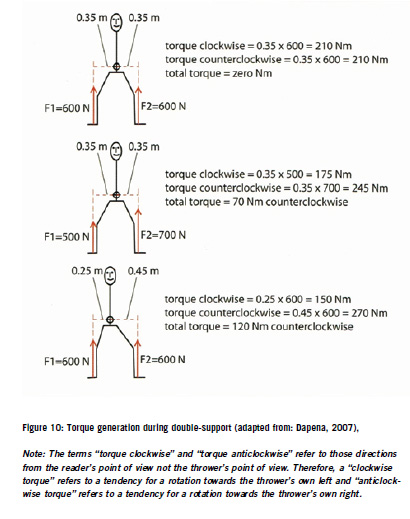 CONCLUSIONS Four factors can be considered influential, causal and interacting during the course of a hammer throw and can be taken into account as a decisive factor affecting the technique of a thrower: a) The angle of inclination of the hammer in each turn. b) Compromise between the turning radius and the impulse in double support, valued by the azimuthal angles of the hammer when the right foot takes off and resumes contact with the ground, in each turn. c) Behavior of the speed of the hammer, both horizontal and vertical, during the throw. d) Angular momentum of the hammer through the vertical and horizontal axis. In general, it can be said that observing the data obtained by higher level throwers, the theory that the hammer can only be accelerated during the period of double support, without the possibility of actively influencing its speed during the single support period is confirmed when only the rotation about the vertical axis (horizontal speed) is taken into account. In this sense, the angular momentum of the hammer generated through the vertical axis is greater during the period of double support than during the single support, in all cases, which implies that the athletes develop a greater amount of force during the double support and that the better throwers are those who reduce their angular momentum less during the single support phase. The truth is that the hammer throw can not be understood only from an azimuthal perspective where the hammer revolves around an axis of vertical theoretical rotation. Analyzing the orbit of the hammer with respect to an inertial reference system, the thrower also goes through a gradual change in the inclination of the plane of the hammer and, consequently also goes through a rotary movement through an axis that is horizontal and identified with the direction of the displacement of the Cg of the hammer throwing system. (Dapena, 1984, 1986). Observing the angular momentum values obtained when analyzing the movement around the horizontal axis, contrary to what happened on the vertical axis, in all cases the highest value of the angular momentum of the hammer is located during the single support period, which agrees with the findings of Dapena (1984, 1986, 1989) and from which it appears that it is possible to increase the speed during the period of single support and that a large part of the increase in the tangential velocity of the hammer is associated with the moment of force generated around the horizontal axis. Comparing the data between higher and lower level throwers, we can conclude that the great difference between high level and other throwers lies in the fact that the difference between the values of angular momentum of the hammer through the horizontal axis (during single support) are remarkable, in that the high level throwers can apply a great force to the hammer through the horizontal axis during the period of single support, while the other throwers have great difficulty to increase their momentum during that phase, especially during the last two turns. Another big difference is that while top throwers achieve a relatively large turning radius during the first turn and keep it throughout the execution of the throw, other throwers get a somewhat shorter turning radius in the first turn, reducing it considerably during the duration of the throw. In memory of: Track & Field pioneer, George Dales (Deligiorgis), 1921-2017 REFERENCES Bondarchuk, A. (1979). Die moderne technik bein hammerwelfen. Leichtathletic Osterreich 2, 3, 22-23. Bondarchuk, A. (1987). Modern technique in hammer throwing. The Throws. European Athletics Coaches Association, XIV Congress, Aix-Les-Bains, Ed: A.E.F.A, 75010 Paris. Bondarchuk, A. (2009). I.A.A.F New Studies in Athletics, v. 4, 2009, p.p. 85. Dapena, J. (1984). The pattern of hammer speed during a hammer throw and influences of gravity on its fluctuations. Journal of Biomechanics, 17, 8, 553-559. Dapena, J. (1986). A kinematic study of center of mass motion in the hammer throw. Journal of Biomechanics, 19, 2, 147-158. Dapena, J. (1989). Some biomechanical aspects of hammer throwing. Athletics Coach, 23 (3), 12-19. Dapena J., & McDonald, C. (1989). A three-dimensional analysis of angular momentum in the hammer throw. Medicine and Science in Sports and Exercise, 21 (2), 206-220. Dapena, J. (2007; 2008). Personal Communication. Gutierrez, M., Soto, V., & Rojas, F. (2002). A biomechanical analysis of the individual techniques of the hammer throw finalists in the Seville Athletics World Championship 1999. I.A.A.F, New Studies in Athletics, 17 (2), 15-26. Gutierrez, D., & Soto, H. (2001). Analisis biomechanico de la lanzamiento de martillo. In: Analisis Biomechanico de los Lanzamientos en Atletismo. Consejo Superior de Deportes, Centro de Alto Rendimiento y investigacion en Ciencias del deporte , Eds: Ministerio de Educacion, 28040 Madrid. Kuznetsov, V. (1965). Path and speed of the hammer in the turns. Legkaya Atletika, 11, 11-12. Maheras, A. (2010). Reassessing Velocity Generation in Hammer Throwing. I.A.A.F., New Studies in Athletics, 24:4, 71-80. Maheras, A. (2011). The Single Support in Hammer Throwing. Techniques for Track and Field & Cross Country, 5 (2), 14-20. Morriss, C. & Bartlett, R. (1994). Biomechanical analysis of the hammer throw. Athletics Coach, 28 (3), 18-27. Morriss, C. & Bartlett, R. (1992). Biomechanical analysis of the hammer throw. Athletics Coach, 26 (3), 11-17. Murofushi, K, Sakurai, S., Umegaki, K, & Takamatsu, J (2007). Hammer acceleration due to the thrower and hammer movement patterns. Sports Biomechanics, 6 (3), 301-314. Panoutsakopoulos, V. (2006). Biomechanical Analysis of the men's hammer throw in the Athens 2006 I.A.A.F. World Cup in Athletics. Department of Physical Education and Sport Sciences, Aristotle University, Thessaloniki, Greece. Samozvetov, A. (1980). The acceleration of the hammer. Legkaya Athletika, 11, 18-20. Tschiene, P. (1977). New Elements in the technique of the hammer throw. Leichtahletik, 16. Wojcik, M. (1980). The hammer throw. Track & Field Quarterly Review, 80, 23-26. Dr. Andreas Maheras is the throws coach at Fort Hayes State University in Kansas and is a frequent contributor to techniques. |








